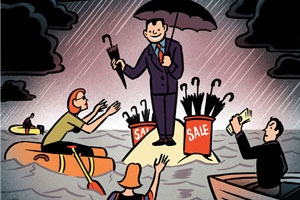
Flickr/<a href="http://www.flickr.com/photos/gorbomb/5385526495/sizes/z/in/photostream/" target="_blank">Sam Gordon Photography</a>
Editor’s note: What’s the best way to adapt to our rapidly warming world? That’s the question journalist Mark Hertsgaard asks in his new book, Hot: Living Through the Next Fifty Years on Earth. The following article is the second of a two-part adaptation about how American cities are preparing for global warming. Part 1, “Why Seattle Will Stay Dry When Your City Floods,” detailed the efforts of Ron Sims, King County, Washington’s forward-thinking former chief executive, to ready greater Seattle for climate change.
As a brawny commercial giant and the hub of America’s transportation network, Chicago could hardly be more different from the leafy, liberal Pacific Northwest Seattle. But nowhere has Seattle visionary Ron Sims‘ climate-change adaptation message had greater influence than in Chicago.
According to Sadhu Johnston, who served as Chicago Mayor Richard M. Daley’s point person on climate change, Chicago’s main champion of adaptation was the mayor himself. About a month after Johnston joined the mayor’s staff in 2006, Daley sent him a note asking, How is climate change going to affect Chicago? “I had to respond that I didn’t really know,” said Johnston. We went back and forth on it a while and finally decided we had to pull in some serious science.” So Johnston and a commissioned a report.
“When we got the impacts study back, it was actually a big relief,” Johnston said. “We’re better off in Chicago than most major cities will be. It turns out there are advantages to not being on a coast. We expect no serious water problems. Our two major concerns over the next 50 years are going to be frequent extreme summer heat and more severe storms, especially in winter.”
But more extreme heat is no small matter: Chicago is already very hot and muggy in summer. By the year 2100, said Johnston, Chicago could experience 30 days a year when the temperature exceeds 100°F (40°C), compared to three days a year currently; on 70 days a year, the temperature will exceed 90°F (35°C), compared to 12 to 15 currently.
“We’ve started to map this stuff,” Johnston told me, unfolding a series of detailed city maps on a worktable in his City Hall office. The first map showed so-called urban heat islands—parts of the city where temperatures were markedly higher than elsewhere. A second map charted density of tree cover. When Johnston overlaid the second map on the first, the areas of low tree density often overlapped with the areas of high temperatures. “In the past, we planted trees in an ad hoc manner,” he told me. “Now we’re going to target the urban heat islands, which often”—now he overlaid a third map on the first two—”are areas populated by lower-income people, who tend to be more at risk from heat waves.
Chicago also aimed to become America’s capital of wind power manufacturing. Already, eight of the world’s leading manufacturers had chosen Chicago as their North American headquarters, said Howard Learner, the director of the Environmental Law and Policy Center in Chicago. Learner explained, “They’re here because the Midwest is the Saudi Arabia of wind power. There are 25,000 megawatts of wind power now under development in Illinois, Minnesota, Iowa, and the Dakotas.” Chicago offered the transportation infrastructure, manufacturing facilities, skilled labor, and positive policy environment these companies needed, Learner said. “The blades of modern wind turbines are two hundred feet long. They’re not like refrigerators you can manufacture in China, put on a container ship to California, and truck over the Rocky Mountains to sell at Best Buy in Peoria. That’s why wind manufacturing—not just turbines but gear boxes, switches, ball bearings—is coming to the Midwest.”
Meanwhile, the city was experimenting with more advanced methods of green practices. Johnston and I left City Hall and walked a few blocks to an alleyway that led from the Goodman Theatre to the Chicago Theatre. At first glance, the alley didn’t look unusual. But Johnston drew my attention to ground level. The sidewalk looked like normal cement, but in fact it was a substance known as permeable concrete that would help cope with the intense storms climate change would bring: Rain would seep into this substance rather than flash off into storm drains and increase flooding. “We’re also experimenting with a special photocatalytic cement that was developed for the Vatican to keep the Millennium Church white,” Johnston said. “Apparently this cement has a chemical reaction that causes it to eat smog. We’re trying out these ideas at our first ‘green street,’ in the Pilsen neighborhood, to see what works. Infrastructure—the streets, lights, drainage systems—makes up 25 percent of Chicago. That is a huge green opportunity.”
Interviewing Johnston the day before the 2008 presidential election, I asked if he would be moving to Washington to pursue a green agenda as part of the Obama administration. “No, cities are where it’s at,” he replied. “Cities are the economic engine of the country. They’re where 80 percent of the population lives, so city governments can have a huge impact on environmental issues.” Then a smile creased his boyish face and he added, “But it will be really nice to have some federal assistance for a change.”
Little did Johnston know that some of the federal assistance would come from none other than Ron Sims. Although Sims had backed Hillary Clinton in the Democratic presidential primaries, President Obama chose him in early 2009 to be the deputy secretary of the Department of Housing and Urban Development. In accepting the No. 2 post at the $39 billion agency, Sims said he looked forward to helping America “prepare for the age of global warming,” adding, “Success can only come if we transform our major metropolitan areas.” He soon showed what he had in mind. In June 2009, HUD joined with the Department of Transportation and the Environmental Protection Agency to announce a Partnership for Sustainable Communities, an initiative that closely parallels policies Sims had championed in King County.
From now on, the announcement said, the federal government would “provide more transportation choices”—read: “encourage mass transit more than private vehicles.” It would also “promote equitable, affordable housing”—read: “encourage developments like Greenbridge”—and “support existing communities”—read: “stop subsidizing sprawl.”
True, announcing a policy in Washington is just the beginning of making it happen on the ground across the country. But the Partnership for Sustainable Communities represents a 180-degree shift in direction for the federal government. If Sims and his new colleagues can make good on their promises, they may inspire the tsunami of adaptation he yearned for, after all.
New York City
Richard Daley was not the only US big-city mayor following in Sims’s footsteps. Mayor Michael Bloomberg of New York City actually was slightly ahead of Daley in launching a comprehensive climate action plan. In a speech he delivered on Earth Day, 2007, to hundreds of government, business, and community leaders at the American Museum of Natural History, Bloomberg declared that coping with climate change was imperative to New York’s future. As a coastal city, he pointed out, New York was particularly threatened by “rising sea levels and intensifying storms.” Climate change would also worsen New York’s already ferocious summertime heat and humidity and stress its water and energy supplies. Bloomberg urged facing these problems “not in the future, not when it’s too late, but right now.” Toward that end, his speech outlined a long-term sustainability plan for the city, a plan he called PlaNYC.
One of the most expensive proposals in PlaNYC was the investment it proposed to make in the aging system of aqueducts and tunnels that bring New York its water. The vast majority of New York’s water originates in the Catskill and Delaware River watersheds, hundreds of miles away. Two massive tunnels deliver this water to the city. But neither tunnel had been inspected for more than 50 years; authorities literally had no idea what shape they were in. What they did know was that a failure in either tunnel would leave millions of New Yorkers without water. They also knew that climate change would increase the stress on the water system, because the northeast of the United States was projected to experience more volatile rainfall in the years to come, and this would produce larger pulses of water pouring through the tunnels. PlaNYC’s solution was to urge the completion of the long-planned but always-postponed Water Tunnel No.r 3. Completing the tunnel would cost billions, but it would enable temporary closure of Water Tunnels 1 and 2 so engineers could inspect and modernize them. This was an investment the city could not afford not to make, Bloomberg argued.
Completing Water Tunnel No. 3 illustrates how adaptation is a win-win proposition, said Cynthia Rosenzweig, a senior research scientist at the Goddard Institute for Space Studies at Columbia University and the chief science adviser on New York’s plan. Under Rosenzweig’s leadership, New York City had established what she called “a local version of the IPCC” to provide ongoing scientific advice to decision makers in both the public and the private sectors as they refined and implemented the vision of PlaNYC. Like the IPCC, the New York City Panel on Climate Change was composed of experts from a wide range of physical and social sciences; it issued its first report in February 2009.
Reflecting the uncertainty that plagues most analyses of potential impacts of climate change, Rosenzweig and her colleagues decided to devise two separate projections for future sea level rise: a standard projection and a so-called “Rapid Ice Melt Scenario” projection. Their standard projection concludes that New York must prepare for 7 to 12 inches of sea-level rise by 2050 and 12 to 23 inches by 2080—a considerable but manageable amount. But if, as James Hansen and some other leading climate scientists feared, the earth’s polar ice melts at a rapid rate in the years ahead, the Rapid Ice Melt scenario will tell New York infrastructure managers that they could experience 19 to 29 inches of sea-level rise by 2050 and 41 to 55 inches by 2080—a much more challenging scenario.
Officials cannot make prudent decisions without also improving their knowledge about New York’s existing risks, said Adam Freed, the city government’s deputy director of long-term planning and sustainability. “We need much better flood maps,” Freed told me in April 2010. “Our current maps have a margin of error of three feet. So when Rosenzweig’s group projects two feet of sea-level rise by 2080, or by 2050 under the Rapid Ice Melt Scenario, our current maps could be massively underestimating the total land area that could flood. Or they could be massively overestimating it. We just don’t know.”
To rectify the problem, the city has begun deploying an aerial technology known as LIDAR (Light Detection and Ranging). Airplanes are flown over the city’s landmass and a special laser pulse is sent to earth that measures a given area’s elevation much more precisely than the technologies that inform flood maps compiled by the United States government’s Federal Emergency Management Agency (FEMA).
Nevertheless, mitigation remained the Bloomberg administration’s top climate priority, and its officials made no apologies for that. “I’ll be honest: I fully support adaptation, but I want it to have a lower profile in order to keep the pressure on for aggressive mitigation,” said Rohit Aggarwala, the director of the city’s Office of Long-Term Planning and Sustainability and the mayor’s point person on PlaNYC.
But mitigation has proven a difficult struggle for New York City. One reason is the state government, which in 2008 voted down Bloomberg’s proposal for congestion pricing after the New York City Council had approved it. That defeat in turn undermined Bloomberg’s proposed expansion of mass transit, which was to be financed in part by congestion fees. The state government had also declined the city’s request for a sixfold increase in energy efficiency funding. “Changing the carbon footprint of a city as big as New York is like changing the direction of a supertanker,” Aggarwala told me.
He seemed more optimistic the last time I interviewed him, in April 2010. New York’s electricity consumption per capita had finally fallen in 2008, the most recent data that was available. On the adaptation side of the challenge, a new power plant being built in Sunset Park was being elevated four feet above its original design level to cope with sea level rise. The Parks Department was planting only trees that could manage the heat and precipitation conditions anticipated in the future.
Aggarwala did confess to one lingering frustration. “We have to get people to understand the difference between prevention and resilience,” he said. “Some people think we can keep climate change out somehow; you just build a seawall or a dome or something. You can’t do it. Subways, for example, you can never perfectly protect. They are below sea level by definition and you can’t seal them because you need the heat down there to get out. Instead, our goal has to be to increase our resilience, to get our people and infrastructure through whatever impacts occur as smoothly as possible. But lots of people just want a quick and easy fix. It’s the same mentality as buying a Hummer that runs on bio-diesel—the idea that if I just change this one thing, I can fix the problem. It’s delusional. And insanely frustrating.”
But he was also encouraged that “the level of understanding of the likely impacts of climate change among the people who manage the city’s critical infrastructure, both public and private, has increased tremendously, and that alone has reduced our risk,” he said. “Those people are making much better decisions now.”
This piece was produced by the Climate Desk collaboration.













